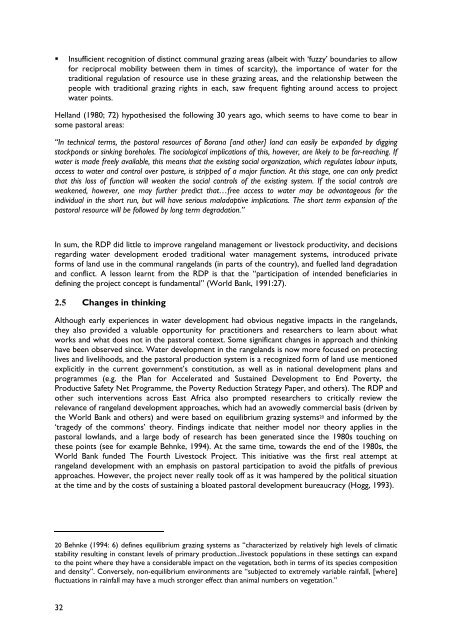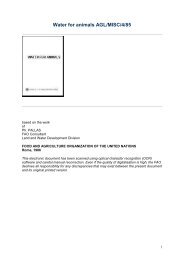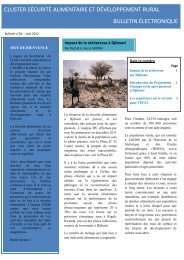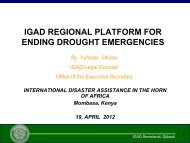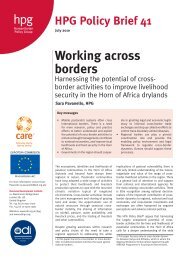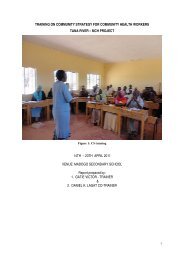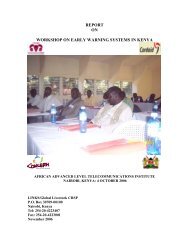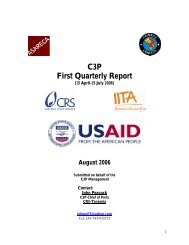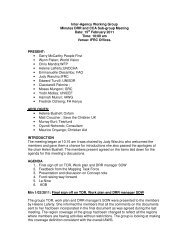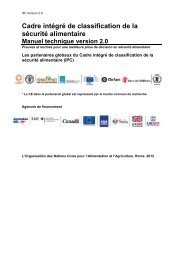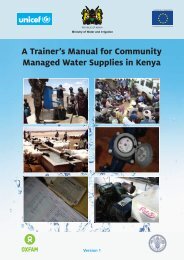• Insufficient recogniti<strong>on</strong> <str<strong>on</strong>g>of</str<strong>on</strong>g> distinct communal grazing areas (albeit with ‘fuzzy’ boundaries to allowfor reciprocal mobility between <strong>the</strong>m in times <str<strong>on</strong>g>of</str<strong>on</strong>g> scarcity), <strong>the</strong> importance <str<strong>on</strong>g>of</str<strong>on</strong>g> water for <strong>the</strong>traditi<strong>on</strong>al regulati<strong>on</strong> <str<strong>on</strong>g>of</str<strong>on</strong>g> resource use in <strong>the</strong>se grazing areas, <str<strong>on</strong>g>and</str<strong>on</strong>g> <strong>the</strong> relati<strong>on</strong>ship between <strong>the</strong>people with traditi<strong>on</strong>al grazing rights in each, saw frequent fighting around access to projectwater points.Hell<str<strong>on</strong>g>and</str<strong>on</strong>g> (1980; 72) hypo<strong>the</strong>sised <strong>the</strong> following 30 years ago, which seems to have come to bear insome pastoral areas:“In technical terms, <strong>the</strong> pastoral resources <str<strong>on</strong>g>of</str<strong>on</strong>g> Borana [<str<strong>on</strong>g>and</str<strong>on</strong>g> o<strong>the</strong>r] l<str<strong>on</strong>g>and</str<strong>on</strong>g> can easily be exp<str<strong>on</strong>g>and</str<strong>on</strong>g>ed by diggingstockp<strong>on</strong>ds or sinking boreholes. The sociological implicati<strong>on</strong>s <str<strong>on</strong>g>of</str<strong>on</strong>g> this, however, are likely to be far-reaching. Ifwater is made freely available, this means that <strong>the</strong> existing social organizati<strong>on</strong>, which regulates labour inputs,access to water <str<strong>on</strong>g>and</str<strong>on</strong>g> c<strong>on</strong>trol over pasture, is stripped <str<strong>on</strong>g>of</str<strong>on</strong>g> a major functi<strong>on</strong>. At this stage, <strong>on</strong>e can <strong>on</strong>ly predictthat this loss <str<strong>on</strong>g>of</str<strong>on</strong>g> functi<strong>on</strong> will weaken <strong>the</strong> social c<strong>on</strong>trols <str<strong>on</strong>g>of</str<strong>on</strong>g> <strong>the</strong> existing system. If <strong>the</strong> social c<strong>on</strong>trols areweakened, however, <strong>on</strong>e may fur<strong>the</strong>r predict that…free access to water may be advantageous for <strong>the</strong>individual in <strong>the</strong> short run, but will have serious maladaptive implicati<strong>on</strong>s. The short term expansi<strong>on</strong> <str<strong>on</strong>g>of</str<strong>on</strong>g> <strong>the</strong>pastoral resource will be followed by l<strong>on</strong>g term degradati<strong>on</strong>.”In sum, <strong>the</strong> RDP did little to improve rangel<str<strong>on</strong>g>and</str<strong>on</strong>g> management or livestock productivity, <str<strong>on</strong>g>and</str<strong>on</strong>g> decisi<strong>on</strong>sregarding water development eroded traditi<strong>on</strong>al water management systems, introduced privateforms <str<strong>on</strong>g>of</str<strong>on</strong>g> l<str<strong>on</strong>g>and</str<strong>on</strong>g> use in <strong>the</strong> communal rangel<str<strong>on</strong>g>and</str<strong>on</strong>g>s (in parts <str<strong>on</strong>g>of</str<strong>on</strong>g> <strong>the</strong> country), <str<strong>on</strong>g>and</str<strong>on</strong>g> fuelled l<str<strong>on</strong>g>and</str<strong>on</strong>g> degradati<strong>on</strong><str<strong>on</strong>g>and</str<strong>on</strong>g> c<strong>on</strong>flict. A less<strong>on</strong> learnt from <strong>the</strong> RDP is that <strong>the</strong> “participati<strong>on</strong> <str<strong>on</strong>g>of</str<strong>on</strong>g> intended beneficiaries indefining <strong>the</strong> project c<strong>on</strong>cept is fundamental” (World Bank, 1991:27).2.5 Changes in thinkingAlthough early experiences in water development had obvious negative impacts in <strong>the</strong> rangel<str<strong>on</strong>g>and</str<strong>on</strong>g>s,<strong>the</strong>y also provided a valuable opportunity for practiti<strong>on</strong>ers <str<strong>on</strong>g>and</str<strong>on</strong>g> researchers to learn about whatworks <str<strong>on</strong>g>and</str<strong>on</strong>g> what does not in <strong>the</strong> pastoral c<strong>on</strong>text. Some significant changes in approach <str<strong>on</strong>g>and</str<strong>on</strong>g> thinkinghave been observed since. Water development in <strong>the</strong> rangel<str<strong>on</strong>g>and</str<strong>on</strong>g>s is now more focused <strong>on</strong> protectinglives <str<strong>on</strong>g>and</str<strong>on</strong>g> livelihoods, <str<strong>on</strong>g>and</str<strong>on</strong>g> <strong>the</strong> pastoral producti<strong>on</strong> system is a recognized form <str<strong>on</strong>g>of</str<strong>on</strong>g> l<str<strong>on</strong>g>and</str<strong>on</strong>g> use menti<strong>on</strong>edexplicitly in <strong>the</strong> current government’s c<strong>on</strong>stituti<strong>on</strong>, as well as in nati<strong>on</strong>al development plans <str<strong>on</strong>g>and</str<strong>on</strong>g>programmes (e.g. <strong>the</strong> Plan for Accelerated <str<strong>on</strong>g>and</str<strong>on</strong>g> Sustained Development to End Poverty, <strong>the</strong>Productive Safety Net Programme, <strong>the</strong> Poverty Reducti<strong>on</strong> Strategy Paper, <str<strong>on</strong>g>and</str<strong>on</strong>g> o<strong>the</strong>rs). The RDP <str<strong>on</strong>g>and</str<strong>on</strong>g>o<strong>the</strong>r such interventi<strong>on</strong>s across East Africa also prompted researchers to critically review <strong>the</strong>relevance <str<strong>on</strong>g>of</str<strong>on</strong>g> rangel<str<strong>on</strong>g>and</str<strong>on</strong>g> development approaches, which had an avowedly commercial basis (driven by<strong>the</strong> World Bank <str<strong>on</strong>g>and</str<strong>on</strong>g> o<strong>the</strong>rs) <str<strong>on</strong>g>and</str<strong>on</strong>g> were based <strong>on</strong> equilibrium grazing systems 20 <str<strong>on</strong>g>and</str<strong>on</strong>g> informed by <strong>the</strong>‘tragedy <str<strong>on</strong>g>of</str<strong>on</strong>g> <strong>the</strong> comm<strong>on</strong>s’ <strong>the</strong>ory. Findings indicate that nei<strong>the</strong>r model nor <strong>the</strong>ory applies in <strong>the</strong>pastoral lowl<str<strong>on</strong>g>and</str<strong>on</strong>g>s, <str<strong>on</strong>g>and</str<strong>on</strong>g> a large body <str<strong>on</strong>g>of</str<strong>on</strong>g> research has been generated since <strong>the</strong> 1980s touching <strong>on</strong><strong>the</strong>se points (see for example Behnke, 1994). At <strong>the</strong> same time, towards <strong>the</strong> end <str<strong>on</strong>g>of</str<strong>on</strong>g> <strong>the</strong> 1980s, <strong>the</strong>World Bank funded The Fourth Livestock Project. This initiative was <strong>the</strong> first real attempt atrangel<str<strong>on</strong>g>and</str<strong>on</strong>g> development with an emphasis <strong>on</strong> pastoral participati<strong>on</strong> to avoid <strong>the</strong> pitfalls <str<strong>on</strong>g>of</str<strong>on</strong>g> previousapproaches. However, <strong>the</strong> project never really took <str<strong>on</strong>g>of</str<strong>on</strong>g>f as it was hampered by <strong>the</strong> political situati<strong>on</strong>at <strong>the</strong> time <str<strong>on</strong>g>and</str<strong>on</strong>g> by <strong>the</strong> costs <str<strong>on</strong>g>of</str<strong>on</strong>g> sustaining a bloated pastoral development bureaucracy (Hogg, 1993).20 Behnke (1994: 6) defines equilibrium grazing systems as “characterized by relatively high levels <str<strong>on</strong>g>of</str<strong>on</strong>g> climaticstability resulting in c<strong>on</strong>stant levels <str<strong>on</strong>g>of</str<strong>on</strong>g> primary producti<strong>on</strong>...livestock populati<strong>on</strong>s in <strong>the</strong>se settings can exp<str<strong>on</strong>g>and</str<strong>on</strong>g>to <strong>the</strong> point where <strong>the</strong>y have a c<strong>on</strong>siderable impact <strong>on</strong> <strong>the</strong> vegetati<strong>on</strong>, both in terms <str<strong>on</strong>g>of</str<strong>on</strong>g> its species compositi<strong>on</strong><str<strong>on</strong>g>and</str<strong>on</strong>g> density”. C<strong>on</strong>versely, n<strong>on</strong>-equilibrium envir<strong>on</strong>ments are “subjected to extremely variable rainfall, [where]fluctuati<strong>on</strong>s in rainfall may have a much str<strong>on</strong>ger effect than animal numbers <strong>on</strong> vegetati<strong>on</strong>.”32
Specific to water development, several trends <str<strong>on</strong>g>and</str<strong>on</strong>g> practices have been noted. These include:• Increased awareness that pastoral areas - where mobile livestock keeping is a central feature -require a different approach to highl<str<strong>on</strong>g>and</str<strong>on</strong>g> areas where sedentary farming practices predominate.Also recognized is that pastoral areas are not homogenous <str<strong>on</strong>g>and</str<strong>on</strong>g> needs <str<strong>on</strong>g>and</str<strong>on</strong>g> dynamics in towns<str<strong>on</strong>g>and</str<strong>on</strong>g> settlements are different to those in open rangel<str<strong>on</strong>g>and</str<strong>on</strong>g>s, requiring c<strong>on</strong>text specific planning.• Increased recogniti<strong>on</strong> that <strong>the</strong> pastoral livelihood is more than just livestock producti<strong>on</strong>, <str<strong>on</strong>g>and</str<strong>on</strong>g> isinfluenced by internal <str<strong>on</strong>g>and</str<strong>on</strong>g> external social, cultural <str<strong>on</strong>g>and</str<strong>on</strong>g> political aspects, which differ between <str<strong>on</strong>g>and</str<strong>on</strong>g>within regi<strong>on</strong>s. These must be properly understood to better inform decisi<strong>on</strong> making related towater development.• Increased recogniti<strong>on</strong> that mobility is an important strategy to resp<strong>on</strong>d <str<strong>on</strong>g>and</str<strong>on</strong>g> adapt to increasingresource variability, <str<strong>on</strong>g>and</str<strong>on</strong>g> that underst<str<strong>on</strong>g>and</str<strong>on</strong>g>ing mobility patterns can better inform waterdevelopment planning.• Increased focus <strong>on</strong> underst<str<strong>on</strong>g>and</str<strong>on</strong>g>ing <strong>the</strong> existing natural resource base in a locati<strong>on</strong> (water <str<strong>on</strong>g>and</str<strong>on</strong>g>pasture) <str<strong>on</strong>g>and</str<strong>on</strong>g> <strong>the</strong> way people use <strong>the</strong>se resources to inform planning, in recogniti<strong>on</strong> that waterpoints functi<strong>on</strong> within <strong>the</strong> broader l<str<strong>on</strong>g>and</str<strong>on</strong>g>scape <str<strong>on</strong>g>and</str<strong>on</strong>g> can alter patterns <str<strong>on</strong>g>of</str<strong>on</strong>g> resource use. Waterpoints can add value when placed strategically <str<strong>on</strong>g>and</str<strong>on</strong>g> sustainably.• Increased awareness that water provisi<strong>on</strong> in <strong>the</strong> rangel<str<strong>on</strong>g>and</str<strong>on</strong>g>s is not <strong>on</strong>ly about availing water forpeople <str<strong>on</strong>g>and</str<strong>on</strong>g> livestock, but also about supporting <str<strong>on</strong>g>and</str<strong>on</strong>g> improving livelihoods. By extensi<strong>on</strong>, value isadded to <strong>the</strong> wider ec<strong>on</strong>omy when livelihoods are supported. Water development is beginningto be coupled with improving livestock marketing opportunities <str<strong>on</strong>g>and</str<strong>on</strong>g> channels, veterinaryservices, rangel<str<strong>on</strong>g>and</str<strong>on</strong>g> health/c<strong>on</strong>diti<strong>on</strong> or rehabilitati<strong>on</strong> <str<strong>on</strong>g>and</str<strong>on</strong>g> o<strong>the</strong>r development interventi<strong>on</strong>s.• Increased recogniti<strong>on</strong> that <strong>the</strong> ‘s<str<strong>on</strong>g>of</str<strong>on</strong>g>tware’ comp<strong>on</strong>ent <str<strong>on</strong>g>of</str<strong>on</strong>g> any water development is as importantas <strong>the</strong> actual physical infrastructure. Focus <strong>on</strong> planning, management <str<strong>on</strong>g>and</str<strong>on</strong>g> sustainability <str<strong>on</strong>g>of</str<strong>on</strong>g> waterpoints is increasing to ensure that water points are appropriate to <strong>the</strong> local c<strong>on</strong>text, that <strong>the</strong>yeffectively serve <strong>the</strong> different needs <str<strong>on</strong>g>of</str<strong>on</strong>g> users, <str<strong>on</strong>g>and</str<strong>on</strong>g> that <strong>the</strong>y remain functi<strong>on</strong>al.• More emphasis is placed <strong>on</strong> <strong>the</strong> rehabilitati<strong>on</strong> <str<strong>on</strong>g>of</str<strong>on</strong>g> existing water points to avoid <strong>the</strong> risksassociated with new developments, especially when project durati<strong>on</strong> is short (for example inemergency relief interventi<strong>on</strong>s).• To address sustainability issues, more emphasis is placed <strong>on</strong> promoting community buy-in towater development (ei<strong>the</strong>r by c<strong>on</strong>tributing in cash or in kind) <str<strong>on</strong>g>and</str<strong>on</strong>g> <strong>on</strong> selecting water pointswhich do not require sophisticated c<strong>on</strong>structi<strong>on</strong> or maintenance, where c<strong>on</strong>structi<strong>on</strong> materials<str<strong>on</strong>g>and</str<strong>on</strong>g> spare parts (where needed) are easily obtainable at <strong>the</strong> local level. There is also increasingfocus am<strong>on</strong>g practiti<strong>on</strong>ers <strong>on</strong> training local artisans to c<strong>on</strong>struct <str<strong>on</strong>g>and</str<strong>on</strong>g> maintain water points inorder to build a cadre <str<strong>on</strong>g>of</str<strong>on</strong>g> local expertise <str<strong>on</strong>g>and</str<strong>on</strong>g> decrease dependency <strong>on</strong> external support (whichmay or may not be available).• Increased awareness <str<strong>on</strong>g>of</str<strong>on</strong>g> <strong>the</strong> value <str<strong>on</strong>g>of</str<strong>on</strong>g> combining scientific <str<strong>on</strong>g>and</str<strong>on</strong>g> customary knowledge systems.Practiti<strong>on</strong>ers increasingly recognize that pastoralists have an important role to play in <strong>the</strong> waterdevelopment process, especially given <strong>the</strong>ir detailed knowledge <str<strong>on</strong>g>of</str<strong>on</strong>g> <strong>the</strong> rangel<str<strong>on</strong>g>and</str<strong>on</strong>g>s, to helpplanners underst<str<strong>on</strong>g>and</str<strong>on</strong>g> needs, dynamics <str<strong>on</strong>g>and</str<strong>on</strong>g> <strong>the</strong> bigger picture at ground level. In Ethiopia, as aresult <str<strong>on</strong>g>of</str<strong>on</strong>g> less<strong>on</strong>s learned from early projects (such as <strong>the</strong> RDP) <str<strong>on</strong>g>and</str<strong>on</strong>g> under <strong>the</strong> currentgovernment, more emphasis has been placed <strong>on</strong> grassroots participati<strong>on</strong> in <strong>the</strong> waterdevelopment process. This is highlighted in <strong>the</strong> current government’s focus (in policy <str<strong>on</strong>g>and</str<strong>on</strong>g>strategy documents) <strong>on</strong> development being driven from <strong>the</strong> woreda level. Approaches toparticipati<strong>on</strong> are evolving from end users simply expressing dem<str<strong>on</strong>g>and</str<strong>on</strong>g> for water, <str<strong>on</strong>g>and</str<strong>on</strong>g> being taskedwith <strong>the</strong> operati<strong>on</strong> <str<strong>on</strong>g>and</str<strong>on</strong>g> maintenance <str<strong>on</strong>g>of</str<strong>on</strong>g> water points planned <str<strong>on</strong>g>and</str<strong>on</strong>g> implemented by outsiders, to33
- Page 1 and 2: Synthesis
- Page 4 and 5: TABLE OF CONTENTSLIST OF ACRONYMS..
- Page 6 and 7: ACKNOWLEDGMENTSI would like to exte
- Page 8 and 9: LIST OF ACRONYMSACDI/VOCAACFAFDCDDC
- Page 10 and 11: EXECUTIVE SUMMARYWater development
- Page 12 and 13: understanding <str
- Page 14 and 15: Agreed upon guidelines for water de
- Page 16 and 17: • Make better use of</str
- Page 18 and 19: to inform their own work an
- Page 20 and 21: Within pastoral areas, it is recogn
- Page 23 and 24: Section 2. Overview of</str
- Page 25 and 26: Dohrn, 2006). Spatially variable ra
- Page 27 and 28: The following broad overview touche
- Page 29 and 30: In areas of adequa
- Page 31: observed response was for individua
- Page 35 and 36: Section 3. Water development todayT
- Page 37 and 38: Eliciting payments for water from l
- Page 39 and 40: ureaus 25 . The ministry’s interv
- Page 41 and 42: National policy paints a conflictin
- Page 43 and 44: will be given to pastoralists to en
- Page 45 and 46: Water supplyGovernance and<
- Page 47 and 48: vulnerable to conversion for other
- Page 49 and 50: • Agro-pastoralists’ priorities
- Page 51 and 52: Although the WSDP principles are se
- Page 53 and 54: The Universal Access ProgramThe Uni
- Page 55 and 56: • Help ensure that public works d
- Page 57 and 58: However, the development model for
- Page 59 and 60: Figure 4: Proposed pilot la
- Page 61 and 62: Many international and</str
- Page 63 and 64: Furthermore, attention is given to
- Page 65 and 66: CARE International, under the GWI,
- Page 67: and traditional me
- Page 70 and 71: • Understand exi
- Page 72 and 73: 4.2 Key observations in the water d
- Page 74 and 75: epresent a firm attempt to preserve
- Page 76 and 77: learning from NGO experiences in Bo
- Page 78 and 79: However, there are currently no spe
- Page 80 and 81: 4.3 Conclusion, ways forward <stron
- Page 82 and 83:
In sum, pastoralism as a livelihood
- Page 84 and 85:
• Water interventions selected sh
- Page 86 and 87:
• Promote effective participation
- Page 88 and 89:
Gebre-Mariam, A. (1982). Organizati
- Page 90:
Schimann P. and Ph


